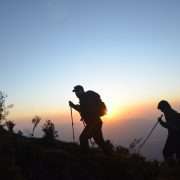
The best time to climb Mount Kenya
The best time to climb Mount Kenya largely depends on your preferred weather conditions and climbing experience. Mount Kenya can be climbed throughout the year, but the weather patterns on the mountain can vary significantly.
Generally, the best time to climb Mount Kenya is during the dry seasons, which are January to February and July to October. During these periods, you can expect relatively clear skies and less rainfall, making the climbing conditions more favorable. The dry seasons also provide better chances of enjoying clear views and landscapes.
It’s important to note that Mount Kenya’s weather can be unpredictable, and conditions can change rapidly. Even during the dry seasons, you should be prepared for the possibility of rain or adverse weather.
If you have specific climbing objectives, such as reaching the summit or attempting technical routes, it’s advisable to consult with experienced local guides or mountaineering experts who can provide you with detailed information about the specific climbing routes and conditions at different times of the year.
Additionally, it’s crucial to acclimatize properly to the altitude before attempting any high-altitude climbs. This typically involves spending several days at progressively higher altitudes to allow your body to adjust to the reduced oxygen levels.
Ultimately, the best time to climb Mount Kenya depends on your personal preferences, climbing experience, and the specific goals you have for your climb.
The best time to climb Mount Kenya is during the dry seasons, which are typically January to February and August to September. During these months, the weather is more stable, and there is less chance of encountering heavy rains, which can make climbing more challenging and hazardous.
The two main climbing routes on Mount Kenya are the Sirimon Route and the Naro Moru Route. Both routes offer stunning scenery and unique experiences, but it’s essential to choose the route that suits your fitness level and preferences.
It’s important to note that even during the dry seasons, weather conditions on Mount Kenya can be unpredictable, so it’s crucial to be well-prepared and equipped for all types of weather. Additionally, it’s recommended to climb during weekdays rather than weekends as the trails are usually less crowded.
If you’re planning to climb Mount Kenya, I highly advise consulting with experienced guides and trekking companies to ensure a safe and enjoyable experience. They can provide valuable insights, assistance, and equipment for a successful climb.
The best time to climb Mount Kenya largely depends on the weather and your personal preferences. However, there are generally two main dry seasons that are considered the best times for climbing: January to February and July to September. During these periods, the weather is typically drier and the skies are clearer, providing better visibility and a more enjoyable climbing experience.
It’s worth noting that Mount Kenya’s weather can be unpredictable, and rain or snow can occur at any time of the year. That said, the dry seasons mentioned above tend to have the most favorable climbing conditions.
It’s recommended to check the weather forecast beforehand and consider hiring a local guide or joining an organized tour. They can provide you with valuable information and ensure your safety during the climb. Additionally, keep in mind that climbing Mount Kenya requires a good level of fitness and acclimatization, so proper preparation is essential regardless of the time of year.
The best time to climb Mount Kenya depends on your preferences and the routes you plan to take. Mount Kenya is located near the equator, and its weather can be unpredictable. However, there are generally two main climbing seasons:
- Dry Season (January to February and July to September): These periods are considered the best time to climb Mount Kenya. The weather is generally drier, and you can expect clear skies and good visibility. January to February is the warmest time, but it can also be crowded. July to September is slightly cooler, and you may encounter fewer climbers.
- Rainy Season (March to June and October to December): Climbing during the rainy season can be challenging due to the wet weather, slippery trails, and reduced visibility. However, if you prefer solitude and don’t mind the rain, you can still climb Mount Kenya during this time. It’s essential to be well-prepared for wet conditions and check the weather forecast before your climb.
- Summit Visibility: If your primary goal is to reach the summit of Mount Kenya, it’s important to consider the visibility at the higher altitudes. Cloud cover can obstruct the views, especially during the rainy seasons. Therefore, aiming for the drier months (January to February and July to September) may increase your chances of clear views from the summit.
- Crowds: Another factor to consider is the number of climbers on the mountain. The high season for climbing Mount Kenya is typically during the drier months, especially from July to September. If you prefer a quieter experience, you may consider climbing during the shoulder seasons (March to May and October to December), although the weather conditions may be less favorable.
- Temperature: Mount Kenya’s temperature varies significantly depending on the altitude. It’s generally colder at higher elevations. It’s important to note that temperatures on Mount Kenya can drop below freezing, so appropriate cold-weather gear is necessary regardless of the season.
It’s worth noting that weather patterns can vary, and even during the dry season, you may encounter rain or mist at higher elevations. Therefore, it’s crucial to be prepared for changing weather conditions regardless of the time of year you choose to climb Mount Kenya. Additionally, it’s recommended to climb Mount Kenya with an experienced guide and to acquire the necessary permits and equipment for a safe and enjoyable climb.
Recent Posts
Mount Kenya Charity walks
Mount Kenya Day Hike
Mount Kenya Challenge Program
All Categories
Tags

Thailand




